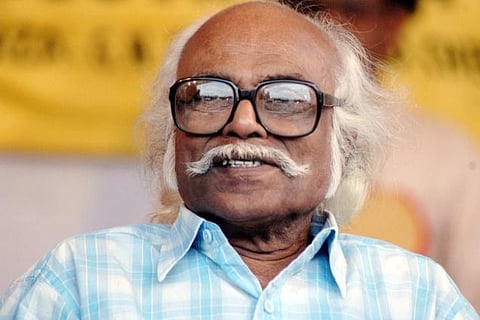

Chennai
One of the greatest post-Independence Indian writers, popularly known as JK, strode into an era where imagined storylines were striding head high. The writers he had to compete with the limited readership available were giants, with people literally waiting at dawn break in railway stations in serpentine queues for the magazine in which their novels were serialised. (The highly imaginative Ponniyin Selvan was the rage.)
JK’s pavement-residing story characters had to compete with bronzed muscle swordsmen and well-endowed damsels pouting poetry in historical fiction. And he survived, thus becoming a milestone in reality writing.
JK was a colossus who strode Tamil literature, and in a career spanning six decades, he authored around 30 novels and 150 short stories. JK was one of the most feted writers in contemporary Tamil literary history with his living room shelf holding almost every award available to a writer in India. Jnanpith Award is the oldest and the premier Indian literary award presented annually to an author for their “outstanding contribution towards literature”. And one of the two Tamil men who received the award is Jayakanthan.
He was born in a farmer’s family in Cuddalore as Murugesan and dropped out of school when he was ten. His lack of schooling never bothered him. When asked about his childhood, JK would say: “Being a school dropout helped me see the entire world as a school and I could personally choose my teachers.”
His refusal to obey infuriated his father. Constant berating made life insufferable and young Jayakanthan would run away at the age of 12 to end up in the Communist Party of India (CPI) office in Madras. Being in a place filled with intellectuals made him climb the literary ladder rather rapidly. Being a compositor of the printing press, proofreader, and assistant editor spurred on the sleeping writer in him. He published his early stories when he was in his teens in a Communist periodical, Samaran.
More than the chance to get published, the George Town CPI office offered JK something totally different. JK got a bagful of characters to depict in his future books. A majority of Jayakanthan’s works revolve around the lives of the underclass pavement dwellers he witnessed on a daily basis. “Every man I came across had an untold story for me to decipher,” he would later say.
With the CPI being banned in 1948, he went underground and was disseminating covert Leftist leaflets. Finally, he went to Tanjore and worked as an assistant in a footwear shop. Soon his writings started appearing in leading periodicals in Tamil. Pudumaipithan, who wrote brazen portrayals of urban working-class life, had just died leaving few to satiate the void. It was JK who took up the baton in liberating Tamil literature of those decades from the shackles of imagination. Was it the realism or did readers realise JK was talking about people they saw without masks in everyday life that attracted them to him? Even in reality writing, a strict regimen had to be followed by Tamil writers. JK shattered that glass ceiling. For instance, his Sila Nerangalil Sila Manithargal was about a genuine friendship that crops up between a rapist and his victim.
People were surprised that unpretentious characterisation in stories, populated by protagonists of true flesh and blood could sell. Soon, with the encouragement of the magazines who saw his potential in portraying the middle class as well (they were the biggest readership base), he was nudged into concentrating on the middle-class urban families of Madras.
The women centricity (female readership was going up in that era) in his stories firmly established a huge following for him. In their words, very few male writers could think like their women characters.
Surprisingly, many protagonists of his later stories were from the Tambram community with which he had little social touch. But it sort of gelled with his anti-Dravidianism.
With 150 short stories showing a cross-section of the Tamil population under the stark reality of his looking glass, JK made a chronicle of the social history of the urban Tamils.
As a contrast from the typical Tamil writer in a kurta and dhoti, he wore normal clothes and had a huge handlebar moustache which he would thoughtfully twirl. He would even shock puritans advocating the use of marijuana.
He did make forays into film-making and politics, but JK is significantly remembered for enhancing modern Tamil literature when he made other writers recall from experiences rather than imagine. To his credit, when JK felt that his creative juices were drying up, he stopped penning fiction. He switched to writing columns. So powerful was his literature that though he didn’t write for a few decades he was yet a force in Tamil literature.
— The writer is a historian and an author
Visit news.dtnext.in to explore our interactive epaper!
Download the DT Next app for more exciting features!
Click here for iOS
Click here for Android